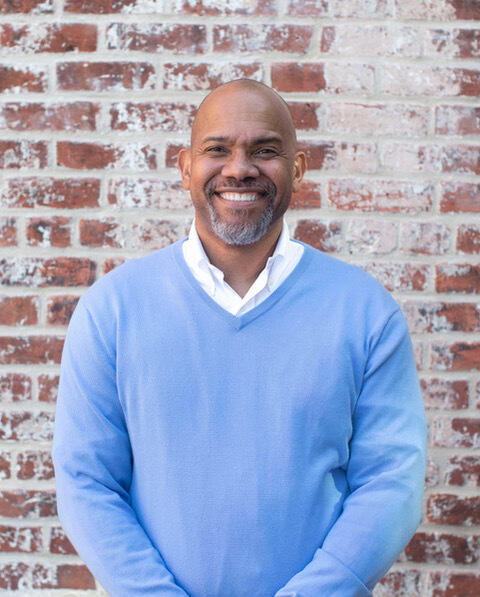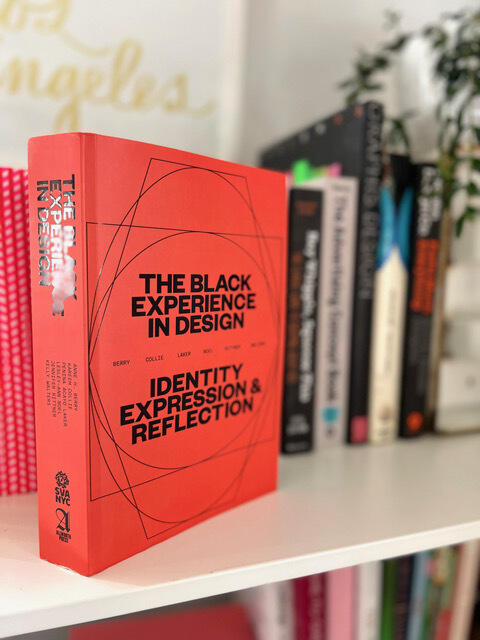
Feb. 23, 2022
Vann Graves reflects on magnifying Black voices and the current creative landscape
‘The Black Experience in Design’ anthology features work by the Brandcenter’s executive director, who describes the importance of building a wall that represents who you are – a wall others cannot look past.
Share this story
With February's release of “The Black Experience in Design: Identity, Reflection & Expression,” Vann Graves, Ed.D., executive director of the Brandcenter at Virginia Commonwealth University and contributor to the anthology, adds another accolade to his already long list of accomplishments.
His segment in the anthology, “Another Brick in the Wall,” discusses the importance of tangible skills and experiences, building a wall of credibility.
Graves, who was born and raised in Richmond, joined the Brandcenter, part of the VCU School of Business, as executive director in 2018. He previously served as chief creative officer at J. Walter Thompson, executive vice president and global executive creative director at McCann New York, and vice president and creative director at BBDO New York. A Fulbright scholar and decorated combat veteran, he holds degrees from Howard University, the Pratt Institute, Harvard University and the University of Pennsylvania.
Graves fondly described his first experience with VCU when he was attending Open High School in Richmond.
“We were able to take college courses while at Open High, and I took a VCU English class. I distinctly remember that opportunity to this day,” he said. “VCU has always been special to me. It’s part of my hometown and an important part of who I am.”
He explained that his role at the Brandcenter is to ensure that students understand creative, business strategy, innovation and how to evolve into or grow as creative problem solvers.
“As part of the Brandcenter, I stand on the shoulders of giants. As a creative and educator, I am proud to be able to carry the torch forward,” he said.
Graves talked to VCU News about his contribution to “The Black Experience” anthology.
Can you talk about your contribution —"Another Brick in the Wall" — and how that discussion fits into your work at the Brandcenter?
I was asked to contribute to the anthology as someone who studied communication design and worked as an art director. The anthology editors acknowledged my experiences as a Black person in this industry who’s witnessed and endured the good, the bad, and the ugly. They asked me: “What is one thing you would tell people about your experience?”
I got the wall idea from my parents while growing up. Being Black, people will sometimes look beyond you and fail to see who you are as a unique individual. You need to build your wall with significant and tangible things that people recognize, and that allow you to subsequently prove yourself.
I call these achievements “bricks” — the accomplishments you list in your resume are perfect examples of your bricks. They consist of the things you spend your time on; the things you mill to perfection. Look at what you have on your wall — degrees, hard skills, experiences … whatever it may be. Today, the first thing people do after meeting or hearing about you for the first time is Google your name to see who you are and what you're about. The more (bricks) you have to show, the better.
What are your feelings about being part of this anthology?
I was honored and excited about being featured in this work during such an important and critical time. We are living through a progressive era that has acknowledged and underscored the need to magnify Black voices — and not just our voices — our thoughts, perspectives and experiences. The human experience is not limited to, or confined within, any one race. We all may struggle to understand how we fit into the world.
It is a perfect time to reflect on how we, as people of color (especially Black), are seen in this country, how we see ourselves, and how others see us. We have been overlooked and undervalued through much of this country’s history, and that inevitably plays a role in how we go about shaping our identity. I really appreciated the opportunity to make a small contribution to this anthology and share my thoughts on something bigger than myself.

What was your first brush with the field of advertising?
One of my first conversations about entering the advertising world was with Mike Hughes, the late president and creative director of The Martin Agency whose name is on the Brandcenter building (officially known as Mike Hughes Hall). During that conversation, Mike told me that I needed to leave Richmond, gain life experience, and, as a result, a better understanding of the world. According to Mike, a creative’s biggest role is to tell great stories, and to achieve this, we need diverse experiences and perspectives. I took Mike's advice and left Richmond to relocate to D.C. As a part of that first step toward a career in advertising, I completed my undergraduate degree in marketing at Howard University, which paid for itself in dividends. It created a strong foundation for everything I went on to achieve in my career.
Can you talk about how the VCU Brandcenter has progressed in terms of nurturing a culture of creative thinking and craft?
When the Brandcenter was founded as the VCU Adcenter by Diane Cook-Tench, our primary focus was to prepare students for a career in advertising. The Adcenter was renamed to the Brandcenter under the tenure of Rick Boyko, who became director in 2003. He recognized a shift in the industry and that it was evolving beyond ads; essentially, he acknowledged that we needed to prepare our students for more.
Today, the Brandcenter is focused on brands and their impact on culture. As businesses change, our direction will change. Creativity and innovation were once perceived to sit separately from the core focus of business, but they have since been recognized as a fundamental part of it. Everything is inextricably linked. And the Brandcenter program trains students to be polymathic and to consider the whole equation when solving complex business problems.
We are preparing students to be the next generation of creative business leaders. Our faculty work hard to ensure our curriculum is constantly evolving to parallel what’s happening in the world of brands and business today.
How have you combined what you learned in the military as a captain with what you learned as creative director into your style of leadership?
My agency experience taught me to focus on craft, innovation and creativity — to strive for the best work possible as a team. Along the way, I’ve learned that great ideas are fragile and should be handled with care.
As creative director, when one of your teams presents a great idea, you need to avoid the temptation to overlay your opinion on that concept. Your role is to help the team grow and further cultivate the idea to express it in the best way possible.
My military experience taught me about the importance of caring for your team. A commander’s job is about leadership, and great leadership involves listening to the needs of the team to complete the mission. You have to trust that your soldiers are doing their job and give them the tools to succeed. Your job as a leader is to ensure your team is properly supported, as this facilitates the success of the overall mission. I apply this approach to my work at the Brandcenter. Our goals are to prepare our students to be best in class. We provide our students with the tools and skills they need to succeed in the workforce.
The building where the Brandcenter is housed, originally the carriage house for the Jefferson Hotel, has special meaning to you. What does it mean to be working in that space?
When I got the job at the Brandcenter, my grandmother told me that my great-grandfather worked at the building when it was the carriage house for The Jefferson Hotel. This building is a piece of my personal history, and I think about that every time I walk through the doors. Though we’re only separated by a few generations, I also think about how different the world was for him, entering this same space. This dichotomy is not lost on me.
Can you tell me how you have been rethinking the ground-floor space and what you would like to accomplish with the renovations?
The ground floor of the Brandcenter has conventionally been a space where our students spend time working and collaborating on projects outside of class. The space was open concept in its initial iteration and vision, with much of it covered by large and unique concrete tables. The layout was designed to nurture collaboration but was only conducive to this one working style. We wanted to account for the fact that people have different work styles to accommodate, and we created a space that allows students to work the way they want. Whether that’s independently or as a team, in the open or in private. The space is designed to be functional and accommodate the diverse needs of our students.
Can you talk about the evolution in the creative world and how it relates to the future of the advertising industry?
Creativity, advertising, marketing and branding are moving in the direction of accessible creativity. You have TikTok influencers who are building and creating multimillion dollar brands on their phones. This was unheard of 10 years ago. You have platforms and tech companies that defy limits, with content, information, art and more at our fingertips. This is revolutionary. It’s a huge leap forward for business as a whole. Technology has made creativity accessible, more democratic. Our phones now allow us to create and generate content at a level that was once reserved for studios. Change is a constant, especially as it relates to technology, and it’s important to keep the pace.
What have you learned after leading the Brandcenter for more than three years?
One lesson that requires constant care and attention is the ongoing endeavor to stay relevant to ensure we are preparing our students for the business world of today and beyond. The byproduct of this effort is a natural way to combat obsolescence.
Subscribe to VCU News
Subscribe to VCU News at newsletter.vcu.edu and receive a selection of stories, videos, photos, news clips and event listings in your inbox.










